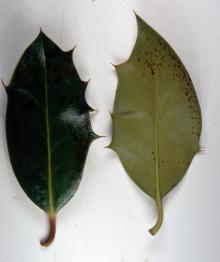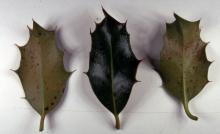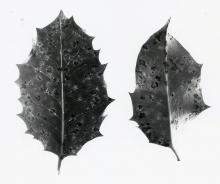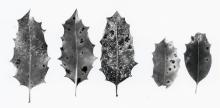Cause Sclerophoma sp., a fungus never identified to species. It does not sporulate readily in plant tissue under field or laboratory conditions but does in culture plates after exposure to ultraviolet light. Symptoms developed 3 months after artificial inoculation. Healthy plants placed in the field in June developed scab by September.
Symptoms English holly has irregular, translucent to reddish black swollen areas on the leaf. Symptoms are mainly on the leaf underside but in some cultivars on both sides. The leaf spot is due to a cellular proliferation in the leaf mesophyll. Generally, epidermal layers remain intact. Symptoms may resemble oedema.
Cultural control Tactics used to control Phytophthora Leaf and Twig Blight might work just as well for this disease.
- Control weeds and brambles to help air circulation.
- Select a site that permits good air drainage.
- Space and prune trees to permit good air circulation.
- Remove and destroy fallen leaves and dead infected twigs during the summer.
Chemical control
- Banner MAXX at 5 to 8 fl oz/100 gal water may be effective. Group 3 fungicide. 12-hr reentry.
- Pageant at 8 to 12 oz/100 gal water. Do not use with organosilicone-based adjuvants. Group 7 + 11 fungicide. 12-hr reentry.
- Spectro 90 WDG is registered for holly at 1 to 2 lb/100 gal water and may also be effective. Group 1 + M5 fungicide. 12-hr reentry.
Reference Brown, W.M. 1970. A leaf spot disease of English holly caused by a species of Sclerophoma. Phytopathology 60:1144-1145.




